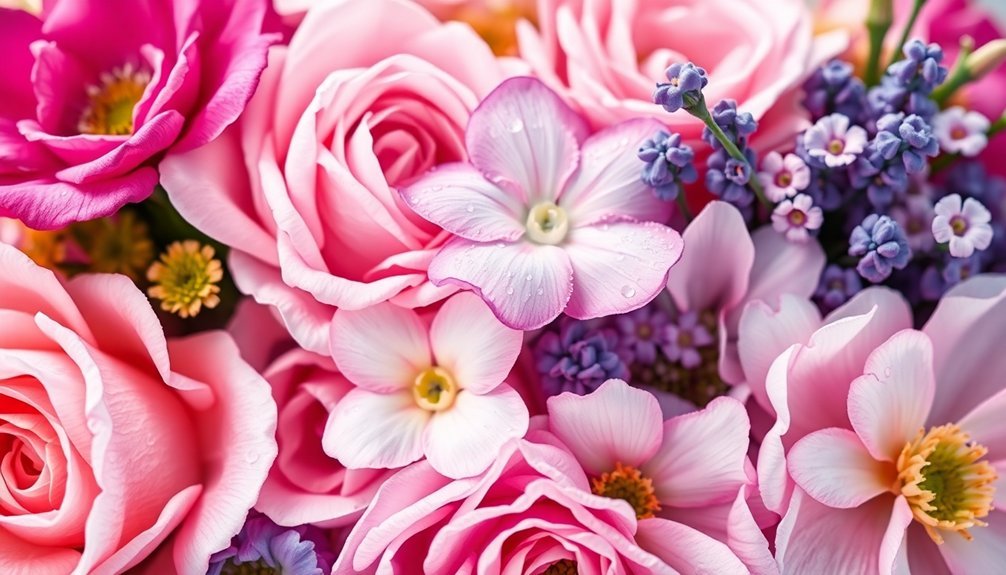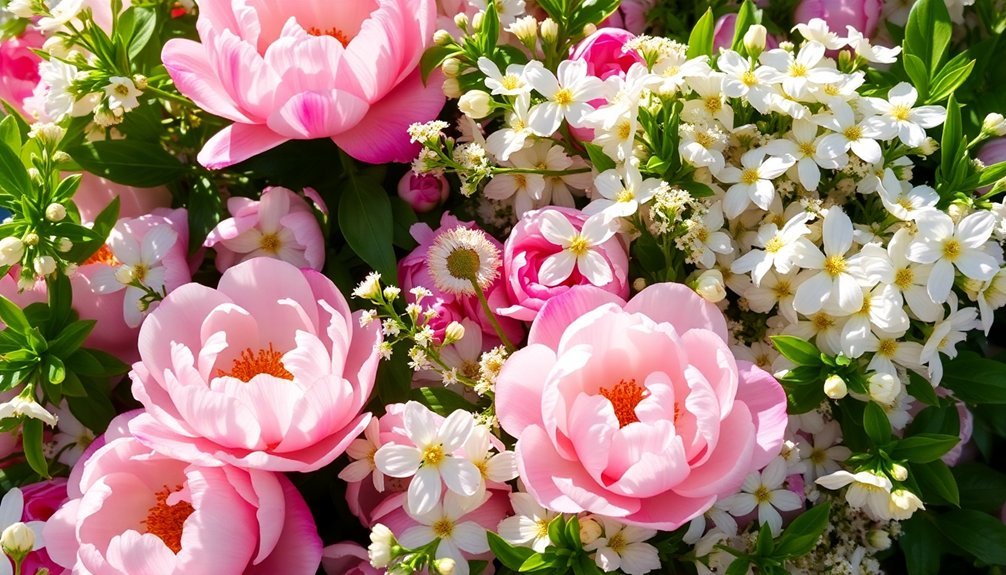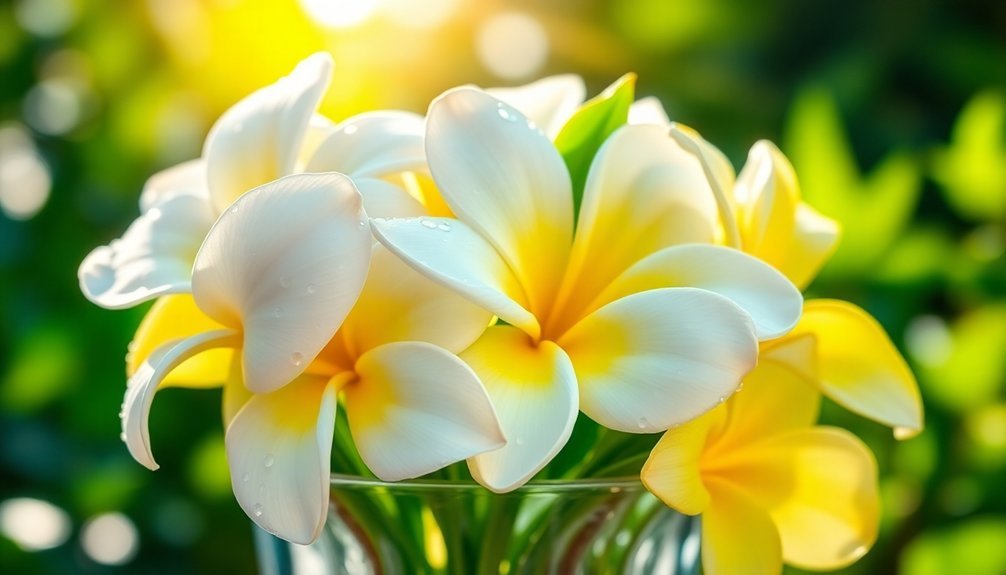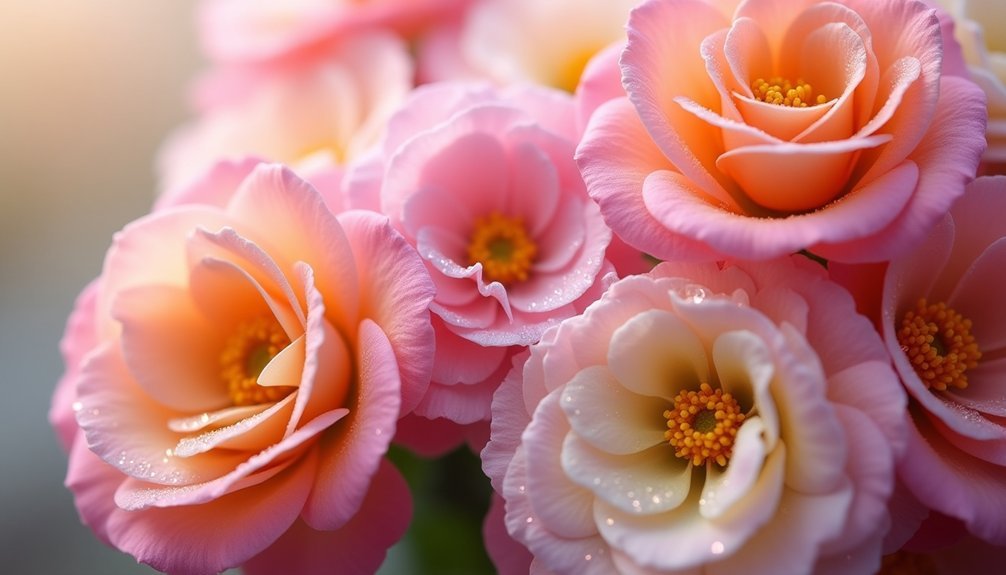When creating floral top note blends, you'll find success pairing lavender with lemon for an invigorating fresh scent, or jasmine with sweet orange for romantic depth. Rose and grapefruit offer sophisticated brightness, while geranium works well with peppermint for a rejuvenating boost. You can enhance these combinations by adding herbal elements like basil or rosemary as anchors. These proven pairings open the door to endless aromatic possibilities.
Understanding Floral Top Notes in Perfumery

When delving into the art of perfumery, you'll quickly discover that floral top notes play an essential role in creating a fragrance's initial impact. These fleeting aromatics set the stage for your entire aromatic experience, typically lasting just 5-10 minutes after application.
When crafting floral essential oil blends, you'll find that popular choices like lavender, bergamot, and geranium essential oil create those vital first impressions that captivate the senses.
The secret to successful blending lies in how you balance these floral top notes with other fragrance families. Whether you're working with citrus or herbal elements, the initial floral notes influence both the complexity of your blend and the emotional response it evokes.
Understanding this delicate interplay helps you create more sophisticated and appealing fragrances.
Essential Floral and Citrus Pairings
You'll discover powerful aromatherapy combinations when pairing jasmine with sweet orange, creating an intoxicating blend that balances floral depth with citrus brightness.
The natural marriage of rose and grapefruit offers a sophisticated fusion that uplifts your mood while maintaining the rose's classic appeal.
Lavender and lemon form an essential pairing that brings together lavender's calming properties with lemon's fresh, invigorating notes.
Jasmine Meets Sweet Orange
The enchanting combination of jasmine and sweet orange essential oils creates a perfect harmony between floral elegance and citrus vibrancy. You'll find this blend will help enhance both creativity and romance while offering a balanced sensory experience. The rich, floral notes of jasmine essential oil perfectly complement the bright, uplifting qualities of sweet orange essential oil.
| Properties | Jasmine | Sweet Orange |
|---|---|---|
| Aroma Type | Floral, Rich | Citrus, Fresh |
| Benefits | Aphrodisiac, Calming | Energizing, Uplifting |
| Best Time | Evening | Morning |
| Ratio | 6 drops | 4 drops |
For ideal results, combine these fragrance oils in your diffuser or create a personal roll-on perfume. This versatile blend works particularly well during creative sessions or when setting a romantic mood.
Rose With Grapefruit Notes
Bright citrus meets romantic floral in the exquisite pairing of rose and grapefruit essential oils.
You'll find this combination striking a perfect balance between uplifting energy and calming serenity. While grapefruit's zesty top notes provide an invigorating boost, rose's deep floral character adds a luxurious depth that transforms this blend into something truly special.
When you're creating this blend for skin care or aromatherapy, remember that less is more with rose essential oils. You can achieve an ideal balance by using a higher ratio of grapefruit to rose.
For a similar but more affordable option, try substituting rose geranium, which offers comparable floral notes.
Whether you're diffusing these oils or applying them topically with a carrier oil, you'll experience a harmonious blend that elevates both mood and energy.
Lavender-Lemon Perfect Match
Among essential oil pairings, lavender and lemon create a harmonious blend that balances floral serenity with citrus energy. You'll find lavender essential oil serving as a soothing middle note, while lemon essential oil brightens the blend with its uplifting top notes.
When you combine these essential oils, you're creating more than just a pleasant scent. The floral sweetness of lavender complements lemon's zesty character, offering both relaxation and revitalization in one blend.
You can easily create this combination by adding three drops of lavender and two drops of lemon to your diffuser. If you prefer topical application, mix these oils with a carrier oil for safe use on skin.
This versatile pairing works perfectly whether you're seeking calm or an energetic boost.
Creating Balance With Herbal Elements
Balancing floral top notes with herbal elements creates depth and complexity in fragrance compositions that you won't achieve with florals alone.
When you combine these essential oils, you'll discover how herbs can ground and enhance your floral blends, making them more sophisticated and well-rounded.
You'll find that herbal notes like basil, thyme, and rosemary serve as perfect anchors for lighter floral fragrances.
Try pairing lavender with rosemary to experience how the herbal component adds an invigorating quality while complementing the sweet floral aspects.
By adjusting the ratios between your floral and herbal elements, you can create custom blends that emphasize either characteristic.
This natural combination evokes the essence of a garden, resulting in revitalizing aromas that feel authentic and balanced.
Seasonal Floral Blend Recommendations

Creating seasonal floral blends allows you to capture nature's shifting moods throughout the year.
For springtime energy, combine sweet orange with lavender to boost your vitality and spark creativity.
When summer arrives, pair neroli essential oil with lemon to achieve an uplifting, bright aroma that perfectly complements warm days.
As autumn approaches, blend ylang ylang essential oil with bergamot to create a cozy atmosphere that adds depth to the cooling weather.
During winter's chilly months, mix geranium with peppermint for a rejuvenating yet comforting scent that brightens dark days.
These seasonal combinations maintain their distinctive floral character as middle and base notes develop, ensuring your blends remain true to their intended purpose throughout each season's unique ambiance.
Strength and Longevity in Floral Combinations
While seasonal floral blends offer distinct aromatic experiences, their staying power depends on thoughtful combinations of complementary notes.
You'll find that floral top notes like sweet orange and lemon create an uplifting initial impression but typically fade within minutes. To enhance their longevity, you'll want to combine them with middle notes and grounding elements.
Try pairing your favorite floral top notes with frankincense essential oil or sandalwood essential oil as base notes. These combinations help anchor the blend and maintain its aromatic profile for several hours.
For best results, use only high-quality essential oils, as synthetic alternatives won't provide the same lasting power. You can also experiment with various floral combinations, such as lavender and ylang-ylang, alongside geranium to create unique, enduring fragrances that maintain their character throughout the day.
Therapeutic Benefits of Floral Top Notes

Floral top notes offer a powerful array of therapeutic benefits that extend beyond their pleasant aromas. When you're looking to enhance your mental well-being through aromatherapy, these essential oils can be your natural allies.
You'll find that lavender's sedative properties help reduce anxiety and improve sleep quality, while citrus-based florals like bergamot boost creativity and energy levels.
These top notes work exceptionally well in combination with other essential oils, creating synergistic blends that amplify their therapeutic benefits. Whether you're seeking stress relief, emotional balance, or a productivity boost, floral top notes can deliver results.
You'll notice how the light, fresh nature of these aromatherapy components helps evoke positive emotional responses, making them effective tools for managing your daily mental and emotional wellness.
Frequently Asked Questions
What Does Floral Fragrance Blend Well With?
You'll find floral fragrances blend perfectly with citrus top notes, herbal scents, woodsy base notes, warm spices, and fruity aromas. These combinations create harmonious scents that'll enhance your fragrance experience.
What Fragrance Blends Well Together?
You'll find that citrus oils blend beautifully with florals like lavender and jasmine, while mint pairs well with sweet orange. Bergamot and ylang-ylang create exceptional combinations for a balanced, harmonious fragrance.
What Fragrance Notes Go Well Together?
You'll find that citrus notes pair wonderfully with florals, like bergamot with ylang-ylang or lemon with geranium. Jasmine works beautifully with lime, while lavender and sweet orange create uplifting combinations.
What Is the 30/50/20 Rule for Essential Oils?
You'll want to blend your essential oils using 30% top notes for initial scent, 50% middle notes for the core fragrance, and 20% base notes for depth. This creates a well-balanced, long-lasting aroma.
In Summary
You'll find endless possibilities when working with floral top notes in your blends. Remember to start with small amounts and adjust gradually as you discover what works best. Whether you're creating a spring-inspired blend or seeking therapeutic benefits, trust your nose and don't be afraid to experiment. Focus on balance, test your combinations thoroughly, and keep detailed notes of your successful pairings for future reference.





Leave a Reply